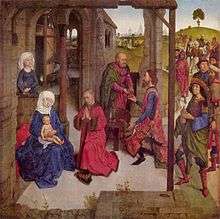Saint Caspar
.jpg)
Saint Caspar (otherwise known as Casper, Gaspar, Kaspar, and other variations) along with Melchior and Balthazar, represents the wise men (Biblical Magi, usually taken as three in number) mentioned in the Bible in the Gospel of Matthew, verses 2:1-9. Although the Bible does not specify who or what the Magi were, since the seventh century, the Magi have been identified in the Western Church as Caspar, Melchior and Balthasar. Caspar and the other two are considered Saints by the Catholic Church.
The name Caspar/Casper is derived from Gaspar which in turn is from an ancient Chaldean word, "Gizbar", which according to Strong's Concordance means "Treasurer". The form "Gizbar" appears in the Hebrew version of the Old Testament Book of Ezra (1:8). In fact, the modern Hebrew word for "Treasurer" is still "Gizbar". By the 1st century B.C. the Septuagint gave a Greek translation of "Gizbar" in Ezra 1:8 as "Gasbarinou" (literally: son of "Gasbar"). The transition from "Gizbar" to "Caspar" and "Kaspar" can thus be summarized as: Gizbar>Gasbar>Gaspar>Caspar>Kaspar (with "C" being a misreading of the manuscript "G" and "K" having the same phonetic value as "C".
Place of origin

Who the magi were is not specified in the Bible; there are only traditions. Since English translations of the Bible refer to them as "men who studied the stars", they are believed to have been astrologers, who could foresee the birth of a "Messiah" from their study of the stars.[1]
Caspar is often considered to be an Indian scholar. An article in the 1913 Encyclopædia Britannica[2] states that "according to Western church tradition, Balthasar is often represented as a king of Arabia, Melchior as a king of Persia, and Caspar as a king of India." Historian John of Hildesheim relates a tradition in the ancient silk road city of Taxila that one of the Magi passed through the city on the way to Bethlehem.
Some consider Caspar to be King Gondophares (AD 21 – c.AD 47) mentioned in the Acts of Thomas. Others consider him to have come from the southern parts of India where, according to tradition, Thomas the Apostle visited decades later. The town by name Piravom in Kerala State, Southern India has for long claimed that one of the three Biblical Magi went from there. The name Piravom in the local Malayalam language translates to "birth". It is believed that the name originated from a reference to the Nativity of Jesus. There is a concentration of three churches named after the Biblical Magi in and around Piravom, as against only another three so named in the rest of India.
There are some who consider that Caspar’s kingdom was located in the region of Egrisilla in India Superior on the peninsula that forms the eastern side of the Sinus Magnus (Gulf of Thailand) by Johannes Schöner on his globe of 1515. On it can be seen Egrisilla Bragmanni ("Egrisilla of the Brahmans"), and in the explanatory treatise which accompanied the globe, Schöner noted: “The region of Egrisilla, in which there are Brahman [i.e. Indian] Christians; there Gaspar the Magus held dominion”.[3] The phrase hic rex caspar habitavit (here lived King Caspar) is inscribed over the Golden Chersonese (Malay Peninsula) on the mappemonde of Andreas Walsperger made in Constance around 1448. Whether it was a latter day king who took the name of Caspar is also not known.
The Magi are now not considered to have been kings. The reference to "kings" is believed to have originated due to the reference in Psalms "The kings of Tharsis and the islands shall offer presents; the kings of the Arabians and of Saba shall bring him gifts: and all the kings of the earth shall adore him" Psalm 72:10.

Gift to Child Jesus
Matthew wrote that the Magi brought three gifts - gold, frankincense and myrrh. These gifts apparently have deeper significance, the gold signifying the regal status of Jesus, the frankincense his divinity, and the myrrh his human nature. Caspar is traditionally portrayed as a young, beardless man who brought frankincense to the Child Jesus.[4]
Death
According to tradition St Caspar became a martyr. Some consider that the other two Magi also met with the same fate. The relics of the Magi were found in Persia by St Helena. These were later brought to Constantinople and then to Milan in Italy. From there they reached Germany, where they are now housed in the Cologne Cathedral.[5]

Veneration
Though the feasts of the Magi are not celebrated liturgically, the Martyrology mentions Gaspar, on the first, Melchior, on the sixth, and Balthasar, on the eleventh of January.[1]
In some parishes, it is traditional to bless chalk for each family so that they may mark the first initial of each of the three Magi over their doors as a blessing for protection.
See also
References
- 1 2 Drum, Walter. "Magi." The Catholic Encyclopedia Vol. 9. New York: Robert Appleton Company, 1910. 2 May 2015
- ↑ "Magi". Encyclopedia Britannica.
- ↑ “Egrisilla regio in qua sunt christiani Bragmanni. ibi Gaspar magus fertur habuisse dominum”, Luculentissima quaedam terrae totius descriptio, Nuremberg, 1515, Tract.II, fol.54 . Schöner’s 1515 globe is reproduced in Chet Van Duzer, Johann Schöner’s Globe of 1515: Transcription and Study, Philadelphia, American Philosophical Society, Transactions, Volume 100.
- ↑ Giffords, Gloria Fraser, Sanctuaries of Earth, Stone, and Light: The Churches of Northern New Spain, 1530-1821, University of Arizona Press, 2007 ISBN 9780816525898
- ↑ "Concerning The Magi And Their Names".
External links
 Media related to Three Wise Men at Wikimedia Commons
Media related to Three Wise Men at Wikimedia Commons

